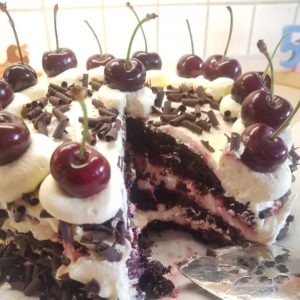 Did you know that the Christian festival of Pentecost is on the Biblical festival of Shavuot, otherwise known as the Festival of Weeks?
Did you know that the Christian festival of Pentecost is on the Biblical festival of Shavuot, otherwise known as the Festival of Weeks?
This Biblical festival comes from the Old Testament, where God’s people were told:
“‘When you enter the land I am going to give you and you reap its harvest, bring to the priest a sheaf of the first grain you harvest. He is to wave the sheaf before the Lord so it will be accepted on your behalf; the priest is to wave it on the day after the Sabbath…
“Count off fifty days up to the day after the seventh Sabbath, and then present an offering of new grain to the Lord.”
This festival is also known as the Feast of Weeks, for the 50 days counted after the Sabbath after Passover. (The word Pentecost is Greek for 50.)
It is also called the Day of First Fruits, as this is what is brought as an offering.
It is one of the three big pilgrimage festivals:
“Three times a year all your men are to appear before the Sovereign Lord, the God of Israel.” Exodus 34:23
The phrase ‘appear before’ in Hebrew uses the word ‘panin’, which literally means ‘face’, but also includes the presence of a person. Moses asked to see God’s ‘panin’, his face, and said, “If your [panin] does not go with us, do not send us up from here.” (Exodus 33:15) When speaking about God, is suggests the tangible presence of his character.
In temple times, this involved God’s people going up to the temple, where the presence of God dwelt in the Holy of Holies. This is where the ‘lechem panin’, the ‘bread face’ or ‘Bread of the Presence’ was kept. Obviously, the pilgrims could not go in to the Holy of Holies to see this bread or behold the ‘face of God’. On the festival days, the tradition was for this bread to be carried out on it’s sacred table, and lifted up before the pilgrims, while the priests called out: “Here is God’s love for you!”
When the temple was destroyed in AD 70, this pilgrimage festival and it’s sacrifices could no longer be carried out, so the festival was converted into one which celebrated God giving his people the Torah on Mount Sinai, which was said to be 50 days after they left Egypt on the very first Passover night.
The Torah , the law of God, is considered pure and white is the colour which symbolises purity, which is where we get our English Whit Sunday.
I noticed that in Leviticus 23:14 it says:
“This is to be a lasting ordinance for the generations to come, wherever you live.” There isn’t anywhere in the New Testament which tells God’s people NOT to celebrate the Biblical feasts, and this one is particularly special, as, like Passover and Easter, when understood better, it brings more depth and richness to a celebration of Pentecost.
In Leviticus 23: 22 we read:
“‘When you reap the harvest of your land, do not reap to the very edges of your field or gather the gleanings of your harvest. Leave them for the poor and for the foreigner residing among you. I am the Lord your God.’”
This is why the story of Ruth is often studied on Shavuot, along with the Psalms, as this day is also the designated birth and death day of King David. (More on that here.)
In her book, The Heavenly Party, Michele Guiness (a Hebrew Christian) says that the Pentecost story can be better understood if we know that the Hebrew word ‘bet’ means ‘house’ and ‘temple’ (i.e. the house of God), and that when the text talks about God’s people waiting in a ‘house’ on the day of Pentecost, she believes it means they were in the temple, and this is how the crowd gathered around them, something which would have been quite tricky if they were in a house. The 3000 people who join their number are then baptised in the sacred baptism pools in the temple, which were designed for baptising a lot of people very quickly. (Again, something which would have been tricky in a house!)
It is traditionally believed that when the Torah was given to God’s people that each person heard it in their own language. This also has a mirror in the story of Pentecost, where the crowd of Pilgrims in Jerusalem for the festival each heard the disciples speaking in their own language.
The festival of Shavuot is fulfilled by the festival of Pentecost. Michele says they define and complete each other. The giving of the Torah on Mount Sinai came with fire as did the coming of the Holy Spirit in Acts 2. Shavuot is the festival first fruits, while Pentecost is when the Spirit came, God’s guarantee of more good things to come. It is the birthday of the church, while Shavuot celebrates the birthday of Judaism.
Some ideas for celebrating Shavuot:
- Make a birthday cake – use red and white as colours of purity and fire – these could be cherries and strawberries of red ribbon or candles. Michele suggests decorating a cake with 7 red ribbons to represent the gifts of the Holy Spirit, and twelve strawberries or cherries to represent the fruit of the spirit. Red candles could represent the 12 tongues of fire and when you blow them out make the sound of a might rushing wind!
- Read of listen to the story of Ruth.
- Read Psalms 113-118, which are the 6 Hallel Psalms read for each pilgrimage festival
- Decorate your house with flowers, because of the tradition that Mount Sinai blossomed when God gave his people the Torah
- Bake a cheesecake or eat other dairy-based foods – this is traditional, possibly because the promised lands was said to be the land of milk and honey
Some links to learning more about Shavuot:
A great little video about Shavuot
About Shavuot by My Jewish Learning
What is Shavuot by The Jewish Chronicle
A Reformed Jewish take on Shavuot including history and customs
And my favourite, always, the food:
Tori Avey’s Cheesecake for Shavuot Explore and celebrate more Autumn feasts in your home with the GodVenture Autumn Feasts Resource Pack
Explore and celebrate more Autumn feasts in your home with the GodVenture Autumn Feasts Resource Pack
